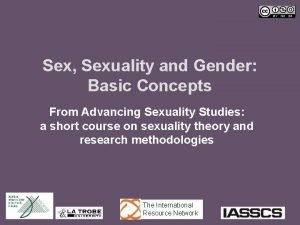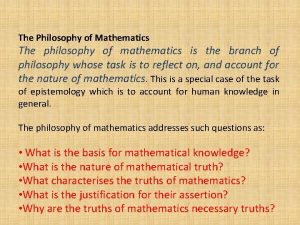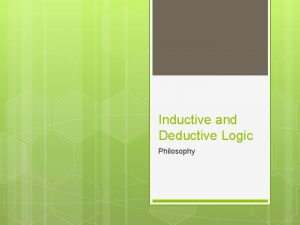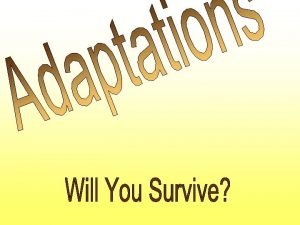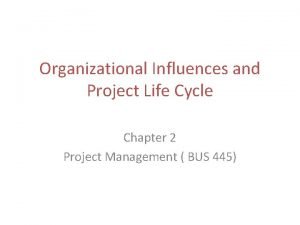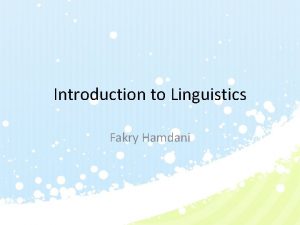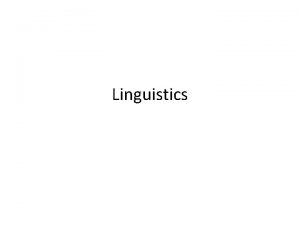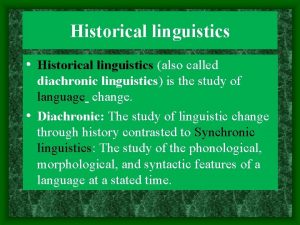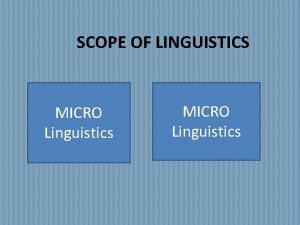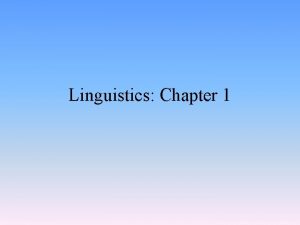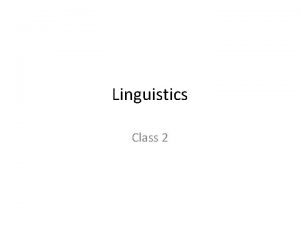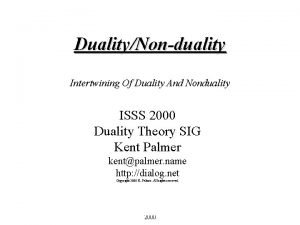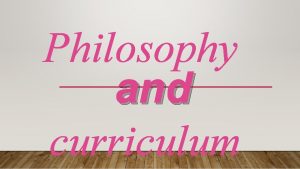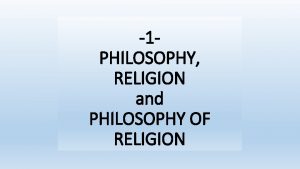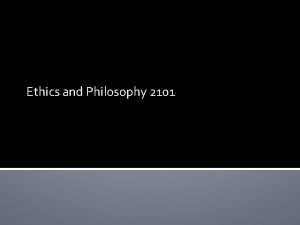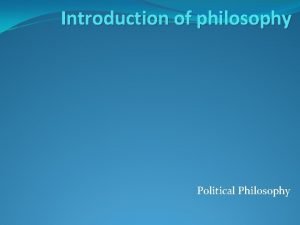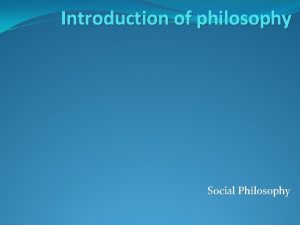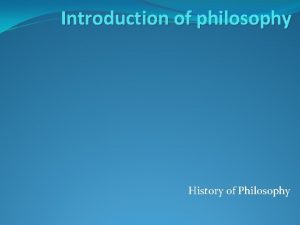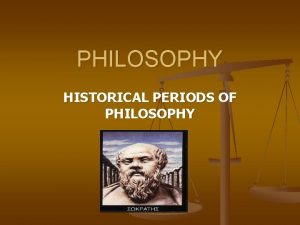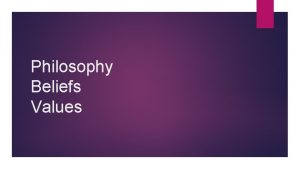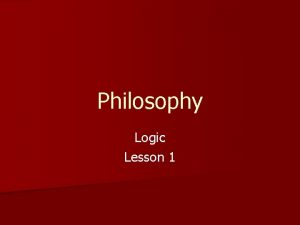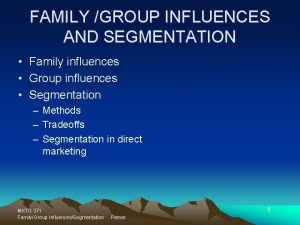The Intertwining Influences of Linguistics Logic and Philosophy
















































- Slides: 48

The Intertwining Influences of Linguistics, Logic, and Philosophy in the History of Formal Semantics. Barbara H. Partee partee@linguist. umass. edu University of Massachusetts, Amherst University of Amsterdam, January 9, 2018

Introduction n n Formal semantics and pragmatics as they have developed over the last 40+ years have been shaped by fruitful interdisciplinary collaboration among linguists, philosophers, and logicians. In this talk I’ll reflect on the growth of formal semantics and formal pragmatics in linguistics and philosophy starting in the 1960’s, including some of key figures in the Netherlands. I’m now working on a book on the history of formal semantics, going beyond what I know first-hand. What I know best comes from my experience as a graduate student of Chomsky’s in syntax at M. I. T. (1961 -65), then as a junior colleague of Montague’s at UCLA starting in 1965, and then, after his untimely death in 1971, as one of a number of linguists and philosophers working to bring Montague’s semantics and Chomskyan syntax together, an effort that Chomsky himself was deeply skeptical about. Jan 9, 2018 University of Amsterdam 2

“Semantics” can mean many different things n n “Semantics” used to mean quite different things to linguists and philosophers, not surprisingly, since different fields have different central concerns. Different research methodologies in different fields also lead to different research: q q n Phonology influenced the use of “semantic features” in early linguistic work. Psychologists experimentally study concept discrimination, concept acquisition, emphasis on lexical level. Syntax has strongly influenced linguists’ notions of “logical form”; ‘structure’ of meaning suggests ‘tree diagrams’ of some sort. Logicians build formal systems; axioms, model theoretic interpretation. ‘Structure’ suggests ‘inferential patterns’. Jan 9, 2018 University of Amsterdam 3

The principal sources of formal semantics Formal semantics has roots in several disciplines, most importantly logic, philosophy, and linguistics. The most important figure in its history was undoubtedly Richard Montague (1930 -1971), whose seminal works in this area date from the late 1960's and the beginning of the 1970’s. n Jan 9, 2018 In the U. S. it’s mostly within linguistics departments now, but in parts of Europe, especially in Amsterdam, it’s still strongly embedded in the context of logic and philosophy. But it is to greater or lesser degrees still a matter of interdisciplinary collaboration almost everywhere. University of Amsterdam 4

Semantics and generative grammar: from before Syntactic Structures to the linguistic ‘wars’. n Before Syntactic Structures – q q q Starting from linguistics within philology (Europe) /anthropology (US), adding a mathematics-influenced “science” perspective, linguistics emerged as a science. Part of the Chomskyan revolution was to view linguistics as a branch of psychology (cognitive science). There were negative attitudes to semantics in American structural linguistics in the 20 th century, probably influenced by logical positivism. Rather little semantics in early American linguistics. Fieldwork tradition: start with phonetics, then phonology, then morphology, then perhaps a little syntax …. European structural linguistics was less anti-semantic. Semantics in logic and philosophy of language: much progress, but relatively unknown to most linguists. Jan 9, 2018 University of Amsterdam 5

Semantics and generative grammar: before Syntactic Structures, cont’d. n n n Evert Beth (1908 -1964) held the chair of Logic and Philosophy of Science at Uv. A from 1947 until his death in 1964, and was one of the forces pushing for the creation of the Centrale Interfaculteit, in part to facilitate intderdisciplinary work. He resisted psychologism in logic, but became interested in the relation between formalized and natural languages, defended Tarski’s semantics against Oxford philosophers, and took an interest in formal approaches to linguistics by Harris, Hjelmslev, and Chomsky. Dick de Jongh, Hans Kamp, Anne Troelstra all came to Amsterdam to work with Beth. Jan 9, 2018 University of Amsterdam 6

2. Semantics in linguistics in 50’s and 60’s n 1954: Yehoshua Bar-Hillel wrote an article in Language inviting cooperation between linguists and logicians, arguing that advances in both fields would seem to make the time ripe for an attempt to combine forces to work on syntax and semantics together. Jan 9, 2018 University of Amsterdam 7

Semantics in linguistics, cont’d. n n 1955: Chomsky, then a Ph. D. student, wrote a reply in Language arguing that the artificial languages invented by logicians were so unlike natural languages that the methods of logicians had no chance of being of any use for linguistic theory. (Chomsky and Bar. Hillel remained friends. ) It took another 15 years or so for the synthesis to begin. Jan 9, 2018 University of Amsterdam 8

Semantics in linguistics, cont’d. n n n Later, Bar-Hillel in 1967 wrote to Montague, after receipt of one of Montague’s pragmatics papers: “It will doubtless be a considerable contribution to the field, though I remain perfectly convinced that without taking into account the recent achievements in theoretical linguistics, your contribution will remain one-sided. ” I. e. , Bar-Hillel hadn’t given up trying to get the logicians and linguists together. Frits Staal of Uv. A also worked on many occasions and in many ways to get linguists, logicians, and philosophers together, including Chomsky and Montague. He founded the journal Foundations of Language with that aim. Staal also edited the transcript from the symposium on “The Role of Formal Logic in the Evaluation of Argumentation in Natural Languages” that he, Bar-Hillel, and Curry organized in 1967 at the 3 rd International Congress for Logic, Methodology and Philosophy of Science in Amsterdam, bringing Montague, Jerry Katz, Dummett, Geach, Hintikka and others together. Jan 9, 2018 University of Amsterdam 9

Syntactic Structures (Chomsky 1957) Paraphrasing: We don’t understand anything about semantics, but deep structure reveals semantically relevant structure that is obscured in surface structure. n Surface structure: (1) a. John is easy to please n Deep structure: (1) b. (for someone) to please John is easy n No actual semantics, but a sense that one test of a good syntax is that it should provide a basis for semantic interpretation. n Jan 9, 2018 University of Amsterdam 10

From Syntactic Structures to Aspects: Katz, Fodor, Postal n n Katz and Fodor (early 60’s) added a semantic component to generative grammar. They addressed the Projection Problem, i. e. compositionality: how to get the meaning of a sentence from meanings of its parts. At that time, “Negation” and “Question Formation” were transformations of declaratives: prime examples of meaningchanging transformations. So meaning depended on the entire transformational history. “Pmarkers” were extended to “T-markers”, to which semantic Projection rules applied. Katz and Fodor’s idea of computing the meaning on the basis of the whole T-marker can be seen as aiming in the same direction as Montague’s derivation trees. Jan 9, 2018 University of Amsterdam 11

The Katz-Postal hypothesis and the Garden of Eden n In a theoretically important move, related to the problem of compositionality, Katz and Postal (1964) made the innovation of putting such morphemes as Neg into the Deep Structure, as in (1), arguing that there was independent syntactic motivation for doing so, and then the meaning could be determined on the basis of Deep Structure alone instead of via a “Negation transformation”. n n n (1) [NEG [Mary [has [visited Moscow]]]] T-NEG [Mary [has not [visited Moscow]]] In Aspects (1965), Chomsky tentatively accepted Katz and Postal’s hypothesis of a syntax-semantics connection at Deep Structure. The architecture of theory (syntax in the middle, with semantics on one side and phonology on the other) was elegant and attractive. This big change in architecture rested on the claim that transformations should be meaning-preserving. “Garden of Eden” period, when Aspects = “the standard theory”. May 6, 2017 Development of Formal Semantics 12

Quantifiers and expulsion from the Garden of n A surprising historical accident was that the behavior of quantifiers was not Eden really noticed until the Katz-Postal hypothesis had for most linguists reached the status of a necessary condition on writing rules. This historical accident was one of the causes of the “Linguistic Wars” of the late 1960’s. n In the ‘standard theory’, (3 a-6 a) would be derived from deep structures associated with (3 b-6 b). Such derivations had seemed meaning preserving, considering only pairs like (2 a-2 b) with proper names. (2) a. John voted for himself. FROM: b. John voted for John. (3) a. Every man voted for himself. FROM: b. Every man vote for every man. (4) a. Every candidate wanted to win. FROM: b. Every candidate wanted every candidate to win. (5) a. All pacifists who fight are inconsistent. FROM: b. All pacifists fight. All pacifists are inconsistent. (6) a. No number is both even and odd. FROM: b. No number is even and no number is odd. May 6, 2017 Development of Formal Semantics 13

The Linguistic Wars of the Late 1960’s n n n The Katz-Postal hypothesis, and hence Chomsky’s Aspects, incorporated the Compositionality Principle: the meaning of a whole is a function of the meanings of its parts and of how they are syntactically combined. In Aspects, the relevant syntactic structure was Chomsky’s Deep Structure. Generative Semanticists (Lakoff, Mc. Cawley, Ross, Postal, early Dowty, Horn, Pieter Seuren) held onto the goal of compositionality and pushed the ‘deep’ structure deeper, making it a kind of logical form. Chomsky had been tentative about adopting the K-P hypothesis, and valuing syntactic autonomy more highly, abandoned it. The Interpretive Semanticists (Jackendoff and some others) held on to a Chomskyan Deep Structure, and proposed semantic rules that interpreted both Deep and Surface structure in a complex architecture. Linguistic wars. And even now, continuing debates about solutions. May 6, 2017 Development of Formal Semantics 14

Logic &Philosophy: Antecedents to Montague n Leibniz (1646 -1716) had a dream of a n n logically perfect language. Boole (1815 -64) developed an algebraic approach to the “laws of thought”. But the greatest foundational figure formal semantics is Gottlob Frege (18481925). His crucial ideas include the idea that function-argument structure is the key to semantic compositionality. He also gave the basis for modern ideas about the logical structure of quantified sentences, and about the distinction between sense and reference. And he is widely* credited with the Principle of Compositionality (*but see Janssen. ) Then Russell, Carnap, Tarski, model theory. Jan 9, 2018 University of Amsterdam 15

The Ordinary Language – Formal Language war. n Around this time, perhaps in light of n n increasing attention to pragmatics and the real use of real languages, the “Ordinary Language” vs “Formal Language” war began within philosophy of language. Ordinary Language Philosophers rejected the formal approach, urged attention to ordinary language and its uses. Late Wittgenstein (1889 -1951), Strawson (1919 -2006). Strawson ‘On referring’ (1950): “The actual unique reference made, if any, is a matter of the particular use in the particular context; …Neither Aristotelian nor Russellian rules give the exact logic of any expression of ordinary language; for ordinary language has no exact logic. ” Jan 9, 2018 University of Amsterdam 16

The Ordinary Language – Formal Language war. n n Russell, ‘Mr. Strawson on referring’ (1957): “I may say, to begin with, that I am totally unable to see any validity whatever in any of Mr. Strawson’s arguments. ” … “I agree, however, with Mr. Strawson’s statement that ordinary language has no logic. ” Note!: both sides in this ‘war’ (and Chomsky!) were in agreement that logical methods of formal language analysis did not apply to natural languages. Jan 9, 2018 University of Amsterdam 17

On the claim that ordinary language has no logic n n n Terry Parsons reports (p. c. ) that when he started thinking about natural language in the late 60’s, he was very much aware of the tradition from Russell that “the grammar of natural language is a bad guide to doing semantics”. But in ‘On denoting’, he realized, Russell had produced an algorithm for going from this ‘bad syntax’ to a ‘good semantics’. That would suggest that the grammar of natural language was not such a bad vehicle for expressing meaning, including the meaning of sentences with quantifiers, definite descriptions, etc. May 6, 2017 Development of Formal Semantics 18

The OL– FL war and responses to it n n n In some respects, that war continues. But the interesting response of some formally oriented philosophers was to try to analyze ordinary language better, including its context-dependent features. The generation that included Prior, Bar-Hillel, Reichenbach, and Montague and his students gradually became more optimistic about being able to formalize the crucial aspects of natural language. We’ve seen Bar-Hillel’s and Staal’s calls in the mid-60 s for linguistics -philosophy cooperation. Arthur Prior (1914 -1969) made great progress on the analysis of tense, one central source of context-dependence in natural languages, which had been omitted from earlier logical languages. Montague, a student of Tarski’s, was an important contributor to these developments. His Higher Order Typed Intensional Logic unified tense logic and modal logic (extending Prior’s work) and more generally unified "formal pragmatics" with intensional logic. Jan 9, 2018 University of Amsterdam 19

Montague’s work n n n Montague unified Carnap’s work and Kripke and Kanger’s on possible worlds; he treated both worlds and times as components of "indices”, and intensions as functions from indices (not just possible worlds) to extensions. Strategy of “add more indices” from Dana Scott’s “Advice on modal logic”. Montague also generalized the intensional notions of property, proposition, individual concept, etc. , into a fully typed intensional logic, extending the work of Carnap (1956), Church (1951), and Kaplan (1964), putting together the function‑argument structure common to type theories since Russell with the treatment of intensions as functions to extensions. Jan 9, 2018 University of Amsterdam 20

Montague’s work, cont’d. n n In ‘Pragmatics and Intensional Logic’, Montague distinguished between ‘possible worlds’ and ‘possible contexts’, and applied his logic to the analysis of a range of philosophically important notions (like event, obligation); this was all before he started working directly on the analysis of natural language. That work, like most of what had preceded it, still followed the tradition of not formalizing the relation between natural language constructions and their logico‑semantic analyses or ‘reconstructions’: the philosopher‑analyst served as a bilingual speaker of both English and the formal language used for analysis, and the goal was not to analyze natural language, but to develop a better formal language. (Montague in Staal (ed. ) 1969 article continued to maintain the latter goal as the more important one. ) Jan 9, 2018 University of Amsterdam 21

A note on the Kalish and Montague textbook. The first edition of Kalish and Montague's logic textbook (1964, but in use n n n years earlier) contains the following passage (p. 10): "In the realm of free translations, we countenance looseness. . . To remove this source of looseness would require systematic exploration of the English language, indeed of what might be called the 'logic of ordinary English', and would be either extremely laborious or impossible. In any case, the authors of the present book would not find it rewarding. " (p. 10) On page 10 of the 2 nd ed. , 1980, the passage is altered: "In the realm of free translations, … would be extremely laborious or perhaps impossible. In any case, we do not consider such an exploration appropriate material for the present book (however, see Montague [4 [Formal Philosophy]] and Partee [1 [ed. , Montague Grammar]]). ” Thanks to Nick Drozd (p. c. ) for alerting me to this quotation and its revision. So Montague’s attitude evidently underwent a change in the late 60’s. Jan 9, 2018 University of Amsterdam 22

Montague’s turn to “linguistic” work. n A new clue about Montague’s motivations: from an early talk version of "English as a Formal Language”, July 31, 1968, UBC, Vancouver: n (I believe I’m deciphering RM’s shorthand right. ) “This talk is the result of 2 annoyances: q The distinction some philosophers, esp. in England, draw between “formal” and “informal” languages; q The great sound and fury that nowadays issues from MIT [i. e. Chomsky and his associates] about a “mathematical linguistics” or “the new grammar” -- a clamor not, to the best of my knowledge, accompanied by any accomplishments. I therefore sat down one day and proceeded to do something that I previously regarded, and continue to regard, as both rather easy and not very important -- that is, to analyze ordinary language*. I shall, of course, present only a small fragment of English, but I think a rather revealing one. ” *Montague’s inserted note: Other creditable work: Traditional grammar, Ajdukiewicz, Bohnert and Backer, JAW Kamp. Later notes (1970) suggest he may have eventually found it not entirely easy. n n Jan 9, 2018 University of Amsterdam 23

Montague’s turn to “linguistic” work, cont’d. n n n But where did the decision to ‘sit down one day and …’ come from? Ivano Caponigro is writing a biography of Montague, about his life and his work. He is convinced that Montague’s semester of teaching at the University in Amsterdam in 1966 was the likely trigger, and from my own research I think it may indeed have been a factor. Montague’s first visit to Amsterdam had been in 1962, where he met Beth, gave logic lectures, and Hans Kamp met him; Kamp subsequently went to UCLA and got his Ph. D. under Montague, and Montague’s EFL and UG papers give much credit to Kamp. In 1966, Staal arranged for Montague to teach in the spring as one of a series of temporary replacements for Beth, who died in 1964. At the same time, Staal was leading a workgroup on formal grammar, and Verkuyl was meeting regularly with Wim Klooster and Jan Luif to read Chomsky’s mathematical work on formal grammars. Jan 9, 2018 University of Amsterdam 24

Montague’s turn to “linguistic” work, cont’d. n At a joint group meeting, Staal and Montague compared Chomsky’s (Aspects) way and Montague’s way of dealing with certain sentences. Verkuyl remembers an interesting contrast: q q q What Frits did was to take a quite long sentence with adverbials (on the corner*, if I remember well). Frits took care of the Aspects way of dealing with this sentence. Montague then presented his own alternative. He did so by climbing on a chair and writing formula after formula on the blackboard. Without too much of an explanation -- and so he was generally considered as a somewhat strange sort of person, however kind he seemed to be. If you force me into terms of contest, it would seem that Frits won at the time in terms of presenting a clear and understandable picture of the formal background of the Aspects model. *note: I found in Montague’s notes from that time a tree diagram for the sentence The store at the corner is a large building – the definite description is quantified in, but the tree is marked “wrong”. Jan 9, 2018 University of Amsterdam 25

Montague’s turn to “linguistic” work, cont’d. n n n Montague’s paper ‘Pragmatics’, his first somewhat language-related one, says in the first footnote that it reports talks given by the author at UCLA in December 1964, in London in June 1966, and in Stockholm in March 1966. One of the spring courses in Amsterdam in 1966 was called ‘Pragmatics and Language. ’ And the first paper in which he really undertakes giving an explicit fragment of syntax and semantics for English, ‘English as a Formal Language’, says in its first footnote that some of the ideas were presented at lectures in Amsterdam in January and February of 1966 and in Los Angeles in March 1968. Hans Kamp recalls Montague lecturing on some of the material at UCLA in Fall 1965. So the Amsterdam semester, together with his trips to London and Stockholm, may not be “the” beginning, but the interactions he had in Amsterdam with Staal and other seminar participants appears to have spurred him to take more seriously the project of applying his logical ideas to the analysis of natural language, and to do things in a better way than Chomsky was doing. Jan 9, 2018 University of Amsterdam 26

Montague’s turn to “linguistic” work, cont’d. n So Montague’s first work on natural language was the provocatively n n n titled "English as a Formal Language" (Montague 1970 b, “EFL”). When he gave relevant lectures on it at Uv. A in Spring 1966, at least Henk Verkuyl, Frits Staal, Simon Dik, Jan Kooij were there. EFL famously begins "I reject the contention that an important theoretical difference exists between formal and natural languages. ” As noted by Bach (1989), the term "theoretical" here must be understood from a logician's perspective and not from a linguist's. What Montague was denying was the logicians' and philosophers' common belief that natural languages were too messy to be formalizable; what he was proposing, here and in his “Universal Grammar”, was a framework for describing syntax and semantics and the relation between them that he considered compatible with existing practice formal languages and an improvement on existing practice for the description of natural language. Jan 9, 2018 University of Amsterdam 27

Montague’s turn to “linguistic” work, cont’d. n n The Fregean principle of compositionality was central to Montague’s theory and remains central in formal semantics. The Principle of Compositionality: The meaning of a complex expression is a function of the meanings of its parts and of the way they are syntactically combined. Montague’s syntax-semantic interface: Syntax is an algebra of ‘forms’, semantics is an algebra of ‘meanings’, and there must be a homomorphism mapping the syntactic algebra into the semantic algebra. Compositionality is the homomorphism requirement. The nature of the elements of both the syntactic and the semantic algebras is left open; what is constrained by compositionality is the relation of the semantics to the syntax. Jan 9, 2018 University of Amsterdam 28

Montague’s work, cont’d. n n Details of Montague’s own analyses of the semantics of English have in many cases been superseded, but in overall impact, PTQ was as profound for semantics as Chomsky’s Syntactic Structures was for syntax. Emmon Bach (1989) summed up their cumulative innovations thus: Chomsky’s Thesis was that English can be described as a formal system; Montague's Thesis was that English can be described as an interpreted formal system. Jan 9, 2018 University of Amsterdam 29

Montague’s work, cont’d. n n n Montague did not work single‑handedly or in a vacuum; David Lewis has an equal claim to foundational importance, and Montague’s papers include acknowledgements to suggestions from Lewis, David Kaplan, Dana Scott, Rudolf Carnap, Alonzo Church, Terence Parsons, Hans Kamp, Dan Gallin, the author, and others. And there were of course other important early contributors to the development of formal semantics as well. I can only emphasize that I cannot strive for completeness in a short talk; see my past papers relating to the history of the field. And of course I will have more in my planned book. Back to the story … Jan 9, 2018 University of Amsterdam 30

Joint work by linguists and philosophers: Montague Grammar and the development of formal semantics n Montague was doing his work on natural language at the height of the "linguistic wars" between generative and interpretive semantics, though Montague and the semanticists in linguistics had no awareness of one another. n PTQ (Montague 1973) gave recursive definitions of well-formed expressions and of their interpretations, illustrating what Bach christened the "rule‑by‑rule" approach to syntax‑semantics correspondence. That was quite different from both generative and interpretive semantics, which looked for some “level” or “levels” of syntactic description to interpret. (That approach can also be seen in the role played by “LF” in later Chomskyan theories. Perhaps somewhat less so in Minimalism. ) Jan 9, 2018 University of Amsterdam 31

Intro of Montague’s work to linguists in U. S. – early 70’s n n The earliest published introduction of Montague's work to linguists came via Partee (papers starting in 1973) and Thomason (who published Montague’s collected works with a long introductory chapter in 1974). Partee and Thomason argued that Montague's work might allow the syntactic structures generated to be relatively conservative ("syntactically motivated") and with relatively minimal departure from direct generation of surface structure, while offering a principled way to address many of the semantic concerns that motivated some of the best work in generative semantics. Jan 9, 2018 University of Amsterdam 32

Introduction of Montague’s work in the Netherlands n n Summer 1967: Staal, Bar-Hillel, and Curry organized a symposium during the 3 rd Intl. Congress for Logic, Methodology, and Philosophy of Science. On the topic “The Role of Formal Logic in the Evaluation of Argumentation in Ordinary Language”. Bar -Hillel prepared an opening position paper, and participants included Montague, Jerry Katz, Dummett, Geach, Hintikka, and others. As Staal noted in the edited condensed discussion (F of L 1969), quite a few people then knew of Montague’s work, and quite a few knew about MIT linguistics (represented by Katz), but few knew both. Jan 9, 2018 University of Amsterdam 33

Introduction of Montague’s work in the Netherlands, cont’d. n n Van Benthem was assistant professor in philosophical logic in Amsterdam 1972 -77 (then to Groningen 1977 -86, then back to Amsterdam). After the 1973 Keenan conference, where they interviewed Renate Bartsch and heard many exciting papers, Groenendijk and Stokhof asked van Benthem to put Montague’s work on the agenda of his spring 1973 seminar, where they read Montague’s PTQ and UG for the first time. A bit later, Simon Dik, Professor of General Linguistics at Uv. A, formed a group to study PTQ, where Theo Janssen got his first introduction to Montague’s work. Theo wrote a computer program that implemented PTQ for his examination in computation. After Renate Bartsch took up her chair in 1974, Montague grammar gained a regular place in the curriculum in philosophy at Uv. A. Bartsch with her younger colleagues started the Amsterdam Colloquium in 1976. It has been a major regular international forum formal semantics and related fields. Jan 9, 2018 University of Amsterdam 34

Introduction of Montague’s work in the Netherlands, cont’d. -- Simon Dik and Renate Bartsch Jan 9, 2018 University of Amsterdam 35

Introduction of Montague’s work in the Netherlands, cont’d. Groenendijk and Stokhof Jan 9, 2018 University of Amsterdam 36

From puzzles about intensional verbs to Generalized Quantifiers in Montague’s work n n n Montague’s primary motivation was always logic and the use of logic in philosophical arguments, and he explained why that merited some attention to natural language semantics. But Montague’s interest in language seems to have gone beyond what was “required”, even if he didn’t value that interest highly. In high school, he studied Latin, French, and Spanish. In college besides mathematics and philosophy he studied French, Arabic, Hebrew, some Polish, some Greek (p. c. Ivano Caponigro). He continued graduate work in mathematics, philosophy, and Semitic languages, especially with Walter Joseph Fischel in classical Arabic, with Paul Marhenke and Benson Mates in philosophy, and with Tarski in mathematics and philosophy, receiving an M. A. in mathematics in 1953 and a Ph. D. in philosophy in 1957 (the year the Program in Logic and Methodology of Science became official, also the year of Feferman’s Ph. D. ) May 6, 2017 Development of Formal Semantics 37

From intensional verbs to GQs, cont’d. n n Montague’s earliest concentrated work on language-related topics seems to have been in spring 1966 in Amsterdam. Notes from that period show an occupation with pragmatics and indexicality, and with problems of intensional contexts. The other main topic that seems to have concerned Montague from very early on is modal and intensional contexts, including the puzzles about intensionality raised by Quine (1960) and by Buridan. That family of problems was under active discussion among a number of philosophers Montague was influenced by, including Mates, Carnap, and Church, and is reflected in Montague’s first two papers in the 1974 collection, from 1959 and 1960. Montague was clearly interested for some time in the problem of intensional verbs like seeks and conceives; Michael Bennett (1974) notes that we find a suggestion from Montague to Geach about how to treat intensional verbs reported in Geach’s Reference and Generality (1965, p. 432). May 6, 2017 Development of Formal Semantics 38

From intensional verbs to GQs, cont’d. The problem of intensional transitive verbs seems to have occupied Montague’s attention as he was developing his intensional logic. n Some puzzles by Benson Mates provided an impetus for his 1969 paper, “On the nature of certain philosophical entities”, which preceded all his explicitly language-related papers (talk: 1967). (19) Jones sees a unicorn having the same height as a table actually before him. (Mates, with non-veridical ‘see’. ) n Montague handled that via seems to see, which his intensional logic let him treat, but needed something else for seeks or conceives. n In NCPE he analyzes sentences with seeks via paraphrase. He wants to show why, as Quine (1960) had noted, the argument in (9) is not valid, although the analogous argument with finds is valid. (9) 'Jones seeks a unicorn; therefore there is a unicorn’ n May 6, 2017 Development of Formal Semantics 39

From intensional verbs to GQs, cont’d. He first describes a solution that rests on analyzing seek as try to find, symbolizing (9) as (10), which puts the existential quantifier for a unicorn in the premise under the scope of an intensional operator. (10) Tries [Jones, ^ u x (Unicorn [x] & Finds [u, x])] n He gives a similar paraphrase analysis of Buridan’s examples with owe. n Then he raises the question of whether resorting to these paraphrases is necessary. n We may wonder whether it is possible to approximate English more closely within our intensional language. What we can do in the case of 'seeks'—and that of 'owes' would be completely analogous—is to introduce several predicate constants; and it would be possible to define them by means of the following equivalences: [emphasis added, BHP] (15) ☐ x P(x Seeks-a P ↔ Tries [x, ^ u y (P[y] & finds [u, y])]). (16) ☐ x P(x Seeks-the P ↔ Tries [x, ^ u y ( z (P[z] ↔ z = y) & Finds [u, y])]). (17) ☐ x P(x Seeks-two-objects-having P ↔ Tries … [similarly] n May 6, 2017 Development of Formal Semantics 40

From intensional verbs to GQs, cont’d. n n n But he rejects that solution on several grounds, including the need for infinitely many predicate constants, something he had criticized Quine for when Quine suggested treating seeks a unicorn as an unanalyzed predicate constant. Then we find: “If, however, we were to pass to a third-order, rather than a secondorder, language, the situation would change: we should then be able to introduce a single predicate constant in terms of which all notions analogous to those introduced by (14)-(17) could be expressed; I shall give a more detailed account of the situation in a later paper. ” So he had evidently gotten the GQ idea before NCPE was published in 1969. The GQs first appear in print in UG (1970, talks in 69, 70). One of my ‘history’ puzzles is who was first, Montague or Lewis? Both published papers with GQs in 1970, with talks in 1969. I’ve found the birth of the idea for Montague in 3 pages of notes from September 1, 1968, and a letter from DKL suggesting that Montague had priority. May 6, 2017 Development of Formal Semantics 41

From intensional verbs to GQs, cont’d. n n n In the Montague archives in Box 1, Folder 7, “Intensional verbs and Berkeley’s argument”, three pages of notes from September 1, 1968 seem to record his first idea about solving the problem of intensional transitive verbs by giving them “third order” arguments, properties of entities, i. e. intensional versions of generalized quantifiers. I now suppose that is the source of the comment in NCPE that such a thing could be done, an idea that came after the “talk” version of NCPE (early 1967) but before the final manuscript was submitted (presumably sometime in the fall of 1968). I quote from these pages in my Su. B paper to show both that the proposal is explicitly there and that it appears to be new to him at that time. Here are tiny extracts. Page 1 begins with “We can improve on 25 Apr 68”; the second half of the page begins with “Try: ” May 6, 2017 Development of Formal Semantics 42

From intensional verbs to GQs, cont’d. What follows, after some crossings-out, are essentially the GQs of UG and PTQ. n all-R = ^ Q x[ R[x] Q[x] ] n an-R = ^ Q x[ R[x] & Q[x] ] n two-R’s = ^ Q x y[ x ≠ y & R[x] & R[y] & Q[x] & Q[y] ] n the-R = ^ Q x[ {x} = {y: R[y]} & Q[x] ] n Jones = ^ Q[ Q[Jones]] (with the “usual” denotation for the inner occurrence of ‘Jones’) n Thus in general a term ζ of the sort above denotes the property of (being a property) applying to ζ. (Note that at this point he sometimes mixed set notation and lambda notation, and that he had plural as well as singular determiners. ) (There are more details in my 2013 Su. B paper. ) n May 6, 2017 Development of Formal Semantics 43

From intensional verbs to GQs, cont’d. n n n Then on page 2 of the pages dated 1 Sep 68, he works out ‘u seeks an-R’ in this new third-order way and in his old tries-to-find way, and assuming as he did that seek is equivalent to try to find, he shows in three lines that they come out equivalent. And then he writes below that: “So this works. ” And then he checks the equivalences with two-R’s and with all-R’s. The “Try: ” on page 1 and “So this works. ” on page 2 make it pretty clear that this was when intensional generalized quantifiers first occurred to him: they provided a solution to the problem of seeks. In other works one could see that he had been reluctant to go beyond second-order intensional logic. That initial reluctance may account for his choice of the title of PTQ; it hadn’t been at all obvious to him that natural language quantification would need such a treatment. If Ede Zimmermann is right, seek does not require intensional GQ arguments; but GQ theory has been really fruitful whether GQs are ‘right’ in the long run or not. May 6, 2017 Development of Formal Semantics 44

From intensional verbs to GQs, cont’d. n By the late 1960’s, when he was putting a great deal of his energy into his work on natural language, he seems to have been treating it with more respect, and seems to have found it quite interesting. n Hans Kamp writes, “From what I can remember from the many hours …, his interest in natural language was genuine. And even if he started out in the vein of ‘it is all much simpler than you linguists think, if you only start out from the right premises and use the right methods’, he was far too intelligent not to see the problems that come into focus once you sit down in an attempt to get the details …really right. ” (p. c. , December 13, 2012) May 6, 2017 Development of Formal Semantics 45

From intensional verbs to GQs, cont’d. n n n It’s also interesting to compare how he introduces his three “linguistic” papers. Both EFL and UG start with variations on his contention that there is no important theoretical difference between formal and natural languages, and both emphasize the importance of the intensional logic he has developed. PTQ, on the other hand, starts right in about natural language: “The aim of this paper is to present in a rigorous way the syntax and semantics of a certain fragment of a certain dialect of English. ” (p. 247). In all of his philosophical writings, we see his desire to solve significant puzzles; in PTQ, we first see the honorific description “puzzle” applied to linguistic phenomena. “The present treatment is capable of accounting for … a number of other heretofore unattempted puzzles, for instance, Professor Partee’s the temperature is ninety but it is rising and the problem of intensional prepositions. ” (p. 248). May 6, 2017 Development of Formal Semantics 46

Divergence between Europe and US – but not a rift n n Divergence between Europe and the US in the 1990’s: The ILLC was founded in Amsterdam in late 1980’s, with journal JOLLI and the ESSLLI summer schools: equal weight on language, logic, and computation. In the US, the journal Natural Language Semantics was launched in 1992 by Heim and Kratzer, to integrate formal semantics into linguistic theory, and to connect semantics with syntactic theory, unlike the older Linguistics and Philosophy and its predecessor Foundations of Language. And Heim and Kratzer 1998 is a fully post-Montague textbook in formal semantics (with not enough model theory). The Heim and Kratzer textbook stands in marked contrast to the classic Gamut textbook, which appeared in Dutch (Logica, Taal en Betekenis) in 1982 and in English in 1991. The latter is probably still the best introduction to formal semantics for people starting from mathematics or logic; the Heim and Kratzer text is primarily directed to linguists. But I think there’s less separation now than ten or fifteen years ago; the world has clearly become smaller and the internet makes access from everywhere in the world to work done anywhere in the world much easier. Jan 9, 2018 University of Amsterdam 47

Selected references Fuller references can be found in several papers, versions of which are downloadable from my site, http: //people. umass. edu/partee/. n n n Partee, Barbara H. with Herman L. W. Hendriks. 1997. Montague grammar. In Handbook of Logic and Language, eds. Johan van Benthem and Alice ter Meulen, 5 -91. Amsterdam/Cambridge, MA: Elsevier/MIT Press. Partee, Barbara H. 2005. Reflections of a formal semanticist as of Feb 2005. http: //people. umass. edu/partee/docs/BHP_Essay_Feb 05. pdf Partee, Barbara H. 2013. Montague’s “linguistic” work: Motivations, trajectory, attitudes. In Proceedings of Sinn und Bedeutung 17, September 8 -10 2012, eds. Emmanuel Chemla, Vincent Homer and Grégoire Winterstein, 427 -453. Paris: ENS. http: //semanticsarchive. net/sub 2012/Partee. pdf Jan 9, 2018 University of Amsterdam 48
 Language
Language Applied linguistics history
Applied linguistics history Definition of sexuality
Definition of sexuality Is logic a branch of philosophy
Is logic a branch of philosophy Mathematics philosophy
Mathematics philosophy Example of a deductive argument
Example of a deductive argument First order logic vs propositional logic
First order logic vs propositional logic First order logic vs propositional logic
First order logic vs propositional logic Third order logic
Third order logic Combinational vs sequential logic
Combinational vs sequential logic Cryptarithmetic problem logic+logic=prolog
Cryptarithmetic problem logic+logic=prolog Software project wbs example
Software project wbs example Majority circuit
Majority circuit Combinational logic sequential logic 차이
Combinational logic sequential logic 차이 Combinational logic sequential logic
Combinational logic sequential logic Everything that surrounds
Everything that surrounds Project life cycle structures
Project life cycle structures Gdailymail
Gdailymail Hình ảnh bộ gõ cơ thể búng tay
Hình ảnh bộ gõ cơ thể búng tay Bổ thể
Bổ thể Tỉ lệ cơ thể trẻ em
Tỉ lệ cơ thể trẻ em Gấu đi như thế nào
Gấu đi như thế nào Tư thế worm breton
Tư thế worm breton Alleluia hat len nguoi oi
Alleluia hat len nguoi oi Kể tên các môn thể thao
Kể tên các môn thể thao Thế nào là hệ số cao nhất
Thế nào là hệ số cao nhất Các châu lục và đại dương trên thế giới
Các châu lục và đại dương trên thế giới Công thức tính thế năng
Công thức tính thế năng Trời xanh đây là của chúng ta thể thơ
Trời xanh đây là của chúng ta thể thơ Cách giải mật thư tọa độ
Cách giải mật thư tọa độ Phép trừ bù
Phép trừ bù độ dài liên kết
độ dài liên kết Các châu lục và đại dương trên thế giới
Các châu lục và đại dương trên thế giới Thơ thất ngôn tứ tuyệt đường luật
Thơ thất ngôn tứ tuyệt đường luật Quá trình desamine hóa có thể tạo ra
Quá trình desamine hóa có thể tạo ra Một số thể thơ truyền thống
Một số thể thơ truyền thống Cái miệng nó xinh thế
Cái miệng nó xinh thế Vẽ hình chiếu vuông góc của vật thể sau
Vẽ hình chiếu vuông góc của vật thể sau Nguyên nhân của sự mỏi cơ sinh 8
Nguyên nhân của sự mỏi cơ sinh 8 đặc điểm cơ thể của người tối cổ
đặc điểm cơ thể của người tối cổ Giọng cùng tên là
Giọng cùng tên là Vẽ hình chiếu đứng bằng cạnh của vật thể
Vẽ hình chiếu đứng bằng cạnh của vật thể Fecboak
Fecboak Thẻ vin
Thẻ vin đại từ thay thế
đại từ thay thế điện thế nghỉ
điện thế nghỉ Tư thế ngồi viết
Tư thế ngồi viết Diễn thế sinh thái là
Diễn thế sinh thái là


